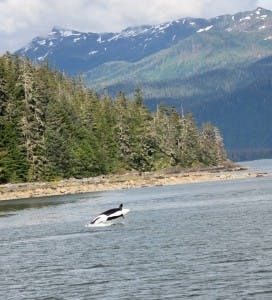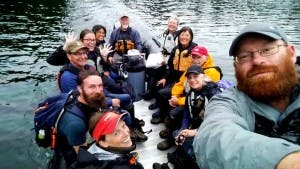Summer 2015, Alaska Newsletter

Dear Friends:
Summer 2015, Alaska Newsletter
As I write this we are southbound in Stephen’s Passage, on our way to Twin Meadows in Endicott Arm. We are making 8.3 knots with the wind and current at our backs, and the sky is fair overhead.
It is a fine day to be on the water, as are almost all days so spent.
 After spending the winter exploring the Sea of Cortez and bashing our way for almost 2000 miles north along the Pacific Coast this spring, it is good to spend time in the quiet and familiar passages, inlets and bays of Southeast Alaska. We were eager to check in on our favorite places; to see if that young brown bear sow with three cubs managed to get them all through the winter; to measure the face of Dawes Glacier to see if it has slowed its rapid retreat (no), and if the storms of winter had made significant changes to the trail on West Brother (some).
After spending the winter exploring the Sea of Cortez and bashing our way for almost 2000 miles north along the Pacific Coast this spring, it is good to spend time in the quiet and familiar passages, inlets and bays of Southeast Alaska. We were eager to check in on our favorite places; to see if that young brown bear sow with three cubs managed to get them all through the winter; to measure the face of Dawes Glacier to see if it has slowed its rapid retreat (no), and if the storms of winter had made significant changes to the trail on West Brother (some).
We are about half way through our Alaska season, and thus far it has been amazing. Not a day goes by that I don’t marvel and give thanks that I am able to do this. This year we were able to spend most of May in Glacier Bay, hosting three ten-day trips spent in the far northern edge of Southeast. The weather was typical May, very little rain, cool nights and some days so warm that every door was open until well after dinner. We had some of our very best mountain goat views on our final trip in the bay, including being on the scene not long after a year old kid slipped and fell to its death, ending up drifting in the water next to Catalyst. The mother raced down the cliff side, trying to protect her baby, and stood on the water’s edge plaintively calling for her little one. It was very, very sad. And also very elemental. That is the way of things, and a clumsy mountain goat cannot be part of the genetic mix that protects the species.
The most impressive thing we saw in Glacier Bay over the last few years has been the explosive growth of the sea otter population, and the resulting expansion of their territory. Last season we saw otters about 15 miles further up the inlet than ever before, this year they have filled the entire bay. We saw them at the head of Tarr Inlet and also in Muir Inlet well above McBride Glacier. In both inlets we saw otters hauling themselves out onto ice flows, as do harbor seals. It was humorous to see them obviously mimicking the seals, but with a twist: the sea otters preferred to lay on the ice on their backs! Which resulted in them frequently sliding off into the water.
Back on our “regular” route we noticed changes in feeding behaviors among the brown bears of Pack Creek. So far, no bears have been digging clams on the landing beach. We can see the clams squirting at low tide, so we know that they’re still there, but no bears have been down to dig for them while we’ve been there. Why? We have no idea. I wonder if they are wise enough to let the clam beds lie fallow for a year, to protect the stocks? Or if other food sources are plentiful enough that the bears are adapting to what is most plentiful? Or if there may be a toxin in the clams that the bears can smell? No one knows, but it is interesting to speculate…..

Over the last few weeks the humpbacks have been gathering along our route. Last week we passed about 50 animals feeding independently along the mainland shore. This bodes very well for some exciting encounters once the herring and candle fish begin showing up later in July.
And we have marveled at the changes in the Baird Glacier outwash plain. In the course of the last three years the glacier ice has withdrawn and a lake has formed along the glaciers’ face. For years we walked up the gravel plain, up onto an ice-cored moraine, and out onto the ice itself. That is no longer possible, but as the lake expanded it totally changed the character of the area, and may perhaps serve as a buffering influence on the irregular floods that have scoured away all new growth on the plain for the past hundred-plus years. Perhaps this is the beginning of the forestation of Baird Glacier? It will be interesting to watch what develops here over the next few years!
And finally, we have met some wonderful people! Increasingly we are hosting guests from all over the world, and hearing stories from other cultures and perspectives. And that brings me to my favorite part of my job, sharing with our wonderful guests the wild places along the Pacific’s eastern shoreline. Every time a guest turns toward me, their face flushed with the excitement of their first glacial calving, or whale breach, or bear drooling as it smells our lunch cooking, it becomes my first as well. Every time.
Thank you for being part of our Pacific Catalyst family, and for making all that we do possible!
Bill Bailey 7.28.15
